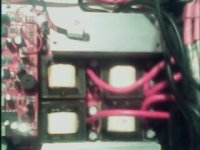Either you do primaries in series and secondaries in parallel (possibly through individual rectifiers) or vise versa - primaries in parallel (possibly through individual inverters) and secondaries in series.hi,
Please help me with right answer. which is best and why?
i want to build 1000 watt converter from dc 12v (vin min 10) to 220ac
i have both sample from china.
thanks
thanks ur faster reply.
but i am asking which is best topology. i am always use parallel primaries and parallel secondaries.
please see my attachment on previous thread .
thanks
but i am asking which is best topology. i am always use parallel primaries and parallel secondaries.
please see my attachment on previous thread .
thanks
hi,
Please help me with right answer. which is best and why?
i want to build 1000 watt converter from dc 12v (vin min 10) to 220ac
i have both sample from china.
thanks
You’re not going to get 220v AC out of either – both circuits show the output being taken from a capacitor fed from a bridge rectifier. So either way, the output is DC not AC.
The difference is, the arrangement you call ‘series output’ will provide a higher voltage but less current. The arrangement you call ‘parallel output’ will provide more current but a lower voltage – assuming that the transformers are the same in both cases.
What I don’t understand is – why don’t you use a single transformer, dimensioned to provide the output voltage and power you require? Why four output transformers?
do like this: primarys in || like in every high current app.
Then series secondarys, for current sharing
But at that point you will have DC, then you would use full bridge to invert that voltage to AC, which wouldn't be sine at that point... But if you know anything of class d audio, or inverters, you could make it sine too, but will be 100x harder, then just invert is at 50 or 60Hz
Then series secondarys, for current sharing
But at that point you will have DC, then you would use full bridge to invert that voltage to AC, which wouldn't be sine at that point... But if you know anything of class d audio, or inverters, you could make it sine too, but will be 100x harder, then just invert is at 50 or 60Hz
Last edited:
You’re not going to get 220v AC out of either – both circuits show the output being taken from a capacitor fed from a bridge rectifier. So either way, the output is DC not AC.
The difference is, the arrangement you call ‘series output’ will provide a higher voltage but less current. The arrangement you call ‘parallel output’ will provide more current but a lower voltage – assuming that the transformers are the same in both cases.
What I don’t understand is – why don’t you use a single transformer, dimensioned to provide the output voltage and power you require? Why four output transformers?
Thanks
I know that its DC. then make it 50hz 220 ac square wave to final output. i have skip it. they use EI 40 core * 4. pri turn is 2+2 with 0.25mm copper foil 15mm width 12inch length, 40KHz frequency per mosfet leg. and secondary for 80v * 4 = 320V . they use 4 strand 0.70mm (22 no wire) * 12 turn. for 2000 watt continuous load and pick 3000 watt.😕 r they injecting current?
r they injecting current?
what do u mean by that.
u cant drew 100 of amps continuously from single 12v battery, largest 12v deep cycle battery in the market is 200ah, to keep safe in theory u can only take say 20 amps from it ok may be 40 amps is fine for it , but 166 – 300 amps no way,
It may explode,
Should use series output scheme, wire thickness depends on many things say for example ambient temp, so u have to try first to see if the wire can handle the amps without causing smoke
hi,
i have found answer.
"There is a large range of EE core sizes, and depending on frequency
and peak flux density, they can deliver output powers from under 5W
up to 5 or possibly 10kW. By using two square-center-leg EE cores side
by side, the core area is doubled, requiring half the number of turns
for the same voltages, peak flux density, and frequency (Faraday’s
law; Eq. 2.7). This doubles the power available from a single core, and
may result in a smaller transformer than using a single core of the next
larger size"
i have found answer.
"There is a large range of EE core sizes, and depending on frequency
and peak flux density, they can deliver output powers from under 5W
up to 5 or possibly 10kW. By using two square-center-leg EE cores side
by side, the core area is doubled, requiring half the number of turns
for the same voltages, peak flux density, and frequency (Faraday’s
law; Eq. 2.7). This doubles the power available from a single core, and
may result in a smaller transformer than using a single core of the next
larger size"
- Status
- Not open for further replies.
- Home
- Amplifiers
- Power Supplies
- Smps Transformer series or parallal

